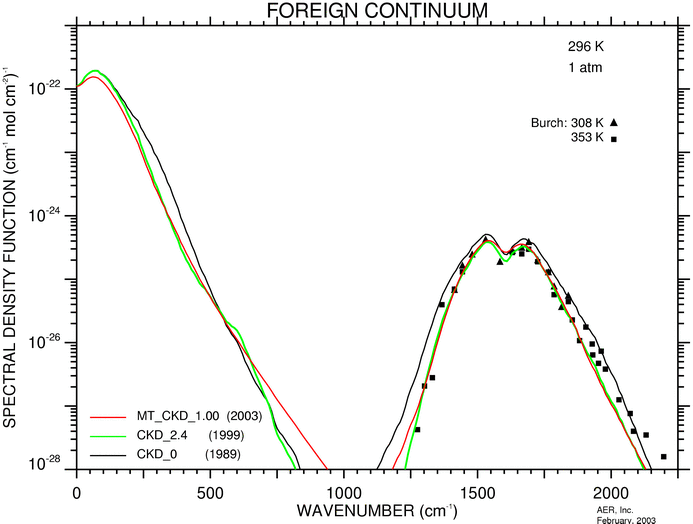-
Notifications
You must be signed in to change notification settings - Fork 10
Home
 |
 |
(still need to rescale self continuum figure)
The MT_CKD continuum model includes continuum absorption due to water vapor, nitrogen, oxygen, carbon dioxide, and ozone. With respect to water vapor, the contributions of the foreign and self continuum are considered separately. The optical depths associated with Rayleigh scattering may also be computed. The MT_CKD model (contnm.f) is available as separate standalone code, and is present in the models LBLRTM and MonoRTM.
The perspective we have adopted in developing the MT_CKD water vapor continuum model is to constrain the model so that it is consistent with quality analyses of spectral atmospheric measurements. Only cases for which the characterization of the atmospheric state has been highly scrutinized have been used. Laboratory measurements are also considered. Keeping the MT_CKD continuum consistent with current observational studies necessitates periodic (typically once per year) updates to the water vapor continuum coefficients. Details of the most recent revisions to the MT_CKD continuum can be found in the “What’s New” Wiki page.
Water vapor continuum coefficients in spectral regions that have not been subject to compelling analyses are determined by a mathematical formulation of the spectral shape associated with each water vapor monomer line. This formulation is applied consistently to all water vapor lines from the microwave to the visible, and the results summed (separately for the self and foreign) to obtain continuum coefficients from 0-20,000 cm-1. This formulation has been derived based on the continuum in spectral regions in which the coefficients are known with low uncertainties.
The current continuum line shape formulation was developed for MT_CKD_1.0 and represented the first recomputation of the entire self and foreign broadened continua since the original CKD model was developed in the 1980s. The self and foreign continuum models are each based on the contributions from two components: a 'weak interaction' component and an 'allowed' line shape component. The change in perspective resulted from the difficulty in developing a line shape model based on sound physics that could explain the magnitude of the increased absorption in the intermediate wing over that provided by the impact approximation. In this formulation, eight and seven parameters are needed to sufficiently specify the self and foreign continua, respectively, over the full spectral domain. The ratio of the self continuum coefficients at 296 K to those at 260 K have been kept the same as in the CKD model. The only temperature dependence for the foreign continuum arises from the radiation term, as with CKD. Both the MT_CKD and CKD model should be regarded as semi-empirical models with strong constraints provided by the known physics.
The MT_CKD water vapor continuum model was first implemented in the line-by-line model LBLRTM v7.0 and has been utilized in all subsequent AER Radiative Transfer models. This new model was developed by E.J. Mlawer, D.C. Tobin and S.A. Clough, using the original CKD formulation as its foundation; hence the name MT_CKD.